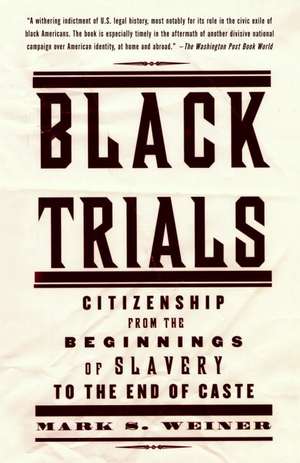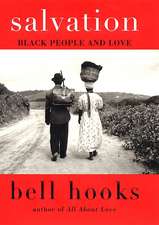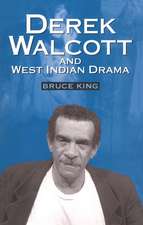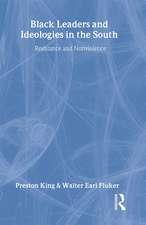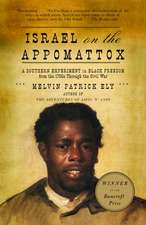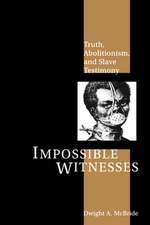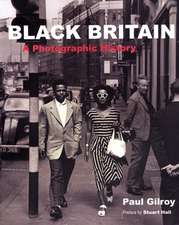Black Trials: Citizenship from the Beginnings of Slavery to the End of Caste
Autor Mark S. Weineren Limba Engleză Paperback – 31 dec 2005
Vezi toate premiile Carte premiată
Connecticut Book Awards (2005)
Spanning three centuries, Black Trials details the legal challenges and struggles that helped define the ever-shifting identity of blacks in America. From the well-known cases of Plessy v. Ferguson and the Clarence Thomas confirmation hearings to the more obscure trial of Joseph Hanno, an eighteenth-century free black man accused of murdering his wife and bringing smallpox to Boston, Weiner recounts the essential dramas of American identity—illuminating where our conception of minority rights has come from and where it might go. Significant and enthralling, these are the cases that forced the courts and the country to reconsider what it means to be black in America, and Mark Weiner demonstrates their lasting importance for our society.
Preț: 216.05 lei
Nou
Puncte Express: 324
Preț estimativ în valută:
41.34€ • 43.28$ • 34.21£
41.34€ • 43.28$ • 34.21£
Carte tipărită la comandă
Livrare economică 03-09 aprilie
Preluare comenzi: 021 569.72.76
Specificații
ISBN-13: 9780375708848
ISBN-10: 0375708847
Pagini: 421
Dimensiuni: 132 x 204 x 25 mm
Greutate: 0.46 kg
Editura: Vintage Books USA
ISBN-10: 0375708847
Pagini: 421
Dimensiuni: 132 x 204 x 25 mm
Greutate: 0.46 kg
Editura: Vintage Books USA
Notă biografică
Mark S. Weiner was born and raised in Los Angeles. After graduating from Stanford University, he received a Ph.D. in American studies and a law degree from Yale. He now teaches constitutional law, legal history, and legal ethics at Rutgers School of Law in Newark, New Jersey.
Extras
1
Let Us Make a Tryal
On May 2, 1721, in Boston, Massachusetts, with New England still contentedly oblivious to the smallpox epidemic that was about to descend, a free black man went on trial for murder. His name was Joseph Hanno, and he was "distinguished from the most of his Complexion" by the breadth of his Christian learning and knowledge of the Bible.The victim was Hanno's wife, a prominent free woman named Nanny Negro. Authorities accused Hanno of beating Nanny over the head with the blunt edge of an ax as she was preparing to go to bed and then slitting her throat with a razor-a "barbarous" and "uncommon" act that struck at one of the central institutions of Puritan society, the holy covenant of marriage.Two months later, as the first red blotches of the pox began to appear on town residents, Joseph Hanno was hanged. Within a year, over 800 Bostonians would succumb to plague and be buried near the town common. It is uncertain how Hanno's executioners disposed of his remains, but they probably did so with little ceremony. They may have given his corpse to a group of slaves and freemen to inter near Copp's Hill, in Boston's North End.
In life, Joseph Hanno was a man of no special consequence. But his crime made him notorious, and to the anxious Puritan mind, which believed that individual crimes reflected the moral state of society as a whole, the outbreak of pox just before his execution must have seemed like a divine punishment visited on a community of sinners. Indeed, Cotton Mather, who was deeply concerned with the spiritual welfare of blacks-he was something of a spiritual egalitarian-had ministered to Hanno in prison, and accused him of bringing "plagues upon all about you." Mather also gave a fire-and-brimstone sermon just before Hanno's execution, drawing a "vast assembly" into the Old North Church as scores of colonists came to gaze upon the doomed ex-slave and consider how the evil deeds of this "miserable African" reflected on their newly afflicted town. Sin. Sickness. Slavery. Law. Hanno's case had illuminated the racial tensions that lay at the heart of Puritan society and spiritual life.
In this story of a poor black criminal brought face-to-face with one of the most prominent divines of the English colonies, we find a question at the dramatic center of American history: what place could blacks have within a civic order defined by a commitment to Christian principles? Cotton Mather had one answer, far more complex than we might expect. In the antebellum South, many Christian slaveholders would hold another view. In the fire of the Harpers Ferry raid of 1859, John Brown, an inheritor of Mather's Puritan tradition, would claim yet another. And in the Civil Rights Movement of the 1950s and 1960s, Martin Luther King, Jr., would offer one more still. The tensions within Mather's answer suggested some of these possible futures.
It was wintertime in New England the night Joseph Hanno killed his wife, when the sun sinks quickly on the horizon. It was a Thursday, and perhaps Nanny felt grateful to be home after a strenuous day of cooking, cleaning, and other chores for some local white family. She had Sunday to look forward to, the Christian day of rest. Or she may have sat at the edge of a bed in a small house in the North End, filled with resentment at her lot in the world, cursing her god or gods, or the man she married.
The two certainly did not get along. Months later, while languishing in prison, Hanno would complain that his wife was ill-tempered and treated him poorly, making his life miserable. Did the two have a fight when Hanno came in late? Did Hanno provoke a confrontation? All we know is that Nanny ended up lying on the bed with her head bashed and throat cut. We also know that after killing her, Hanno rushed outside, exclaiming that his wife had committed suicide, and awakened his neighbors.
Hanno's neighbors probably were some of Boston's small but vibrant community of free blacks, which clustered near the Charles Town ferry in a neighborhood then called New Guinea. They might have been married couples, to judge from obscure colonial records with references to Josiah and Jane, Sebastian and Elizabeth, or Mingo and Sarah. Others probably were some of the men whose full names we can still retrieve from the past: Peter Quaquo, Dick Dudley, Exeter Foxcroft, and Ephraim Boyser. The black population of Massachusetts as a whole was not large, only 2 percent just before the Revolution, but blacks were a significant presence in the port and urban center of Boston. The year Nanny died, blacks there probably numbered between 700 and 1,000 out of a total of 12,000 residents. As Joseph Hanno opened the door and stepped into the street, he probably looked upon rows of houses sheltering scores of former slaves and their descendants.
Hanno had lived in the colonies a long time, forty-four years, having arrived as a child around 1677, in the grim wake of the destruction brought by King Philip's War. He likely came from Madagascar and perhaps had been sold by Muslim traders. We know little specifically about his life, but we do know something of the lives of slaves in New England, which were unlike those in other British colonies. Among other differences, most masters used slaves on small farms, holding only one or two at a time. In accordance with the Old Testament, New England slaves also were typically lodged in their masters' homes, taking meals with them under a common roof. And that intimacy often had an evangelical component. Joseph Hanno's masters "brought [him] up in the Christian Faith," and Hanno, baptized and literate, came to be known in Boston for frequently citing scriptures. In the scornful words of Cotton Mather, he was "always vain gloriously Quoting of Sentences from them wherever [he] came."
The lot of slaves in New England was also unique in one other, critical respect: they were more frequently set free, as Joseph Hanno was in about 1707. A Boston law of that same year required Hanno at times to participate in the "repairing of the highways, cleansing of the streets, or other service, for the common benefit," but otherwise, he was at liberty. By then, he had been in America for about thirty years, and may have been known to the blacks of Boston as a kind of elder, a man rich in hard-earned experience navigating a foreign white land.
Just who Nanny was remains a mystery, though there are some tantalizing clues. She may have been a woman of some standing: in the various directives obliging free black men to do road repair, Hanno is listed consistently as "Jo. Black Nanns husbd" or "Jo Nanneys husbd," the only black man identified in relation to his wife. Perhaps she had been a servant to a prominent white family, or maybe she owned a small business, a rare though not entirely unknown status for free blacks at the time. She may also have been married before. Cotton Mather joined "Anthony Negro & Nannee free negros" in holy union on September 5, 1706. And she may have had at least one child, possibly Joseph's. On August 12, 1715, three days after Hanno had been impressed into roadwork as "Jo. Black Nanns husbd," town records indicated a "Nanney Negro" had given birth to a daughter named Hagar (in Genesis, the Egyptian mother of Ishmael).
After Hanno announced his wife's suicide to his neighbors, someone alerted the town authorities.
Jonathan Pollard, the coroner, arrived from his home on Brattle Street. He brought with him fourteen other men from Boston, a coroner's inquest charged to determine how Nanny had died. We know some of their names (the others are illegible on worn colonial parchment): Samuel Maxwell, Thomas Townsend, John Peake, Mathew Barnot, John Goldthwait, Joshua Kent, William Pitts, and Elias Parkman. Their foreman was Joshua Gee, a famous shipbuilder whose yards lay near Copp's Hill and whose son, the Reverend Joshua Gee, received his Christian upbringing in the Old North Church and later preached there with Cotton Mather. Standing together around the light of lanterns in the cold North End, speaking pointedly with people in the neighborhood, they must have seemed an ominous assembly.
Once each had examined the body, Pollard gathered the group and asked them to explain for the record what had happened. After the men conferred, Pollard produced a form used to document investigations of suspicious deaths in Boston. In a small, even hand, Pollard wrote that Nanny "was murdered by her husband Joseph free Negro of Boston aforesaid by giving her a blow on the back part of the head with an ax & with a repeated blow on the right side of the head as she was going into bed it being then from the instant about ten at the clock at night."
The killing of a man's own wife. The technical term is uxoricide. It not only was a sin, like all other murders, but one that struck deeply at the heart of the Puritan vision of a society of saints: the marital bond, the covenant of husband and wife, and the benevolent exercise of paternal authority, lay at the center of the holy community Puritans were struggling to build in America. To break that bond through adultery was a capital offense, but to break it by murder was unspeakable.
The men each signed their names, and affixed seals next to them in bright red wax.
Hanno was lodged in the town prison on Queen Street, in the center of Boston, where he would await trial. The Superior Court of Judicature, sitting as the "Court of Assize and General Gaol Delivery," would not convene until May. Though some politicians in the Massachusetts House of Representatives, outraged at Hanno's crime and concerned about the cost of keeping him in jail, tried to bend judicial procedure to hasten his execution, justice was not to be rushed. Hanno would have to wait five months before he stood before the law.
In colonial Boston, the philosophy of criminal law was a religious one, derived from the Old Testament and Puritan theology. The stern folk who settled Massachusetts saw themselves as reenacting the biblical story of Exodus, and considered it their duty to enforce God's commands in their new colonial world. Hanno's case would publicly dramatize the place of blacks in relation to this religious conception of law, but even more it would lay bare social tensions and reveal the possibilities of racial inclusion in a Christian community that supported racial slavery. And no one understood this better than Cotton Mather.
For Mather, New England was one of the central battlegrounds in the great struggle between God and the Devil, a war Satan was winning. Born in 1663, he was the eldest son of Increase Mather, who was one of the most prominent ministers of Massachusetts Bay, and the grandson of two other equally renowned church leaders. Driven by strictly orthodox views, he worked tirelessly with his father in the Old North Church to rein in the deviations from hard-line Puritanism that had begun to surface in the colony in the late seventeenth century, and he poured forth a seemingly endless flow of devotional and other writings in service of the Lord (including, though we tend to forget the fact, works on science and medicine, in which he maintained a lively interest). Today, he is best known for his prominent role in the Salem witch trials.
In 1721, Mather was fifty-seven years old, and deeply dissatisfied. It was the sunset of his life, yet his days seemed filled with ceaseless difficulty and conflict. His revered father's health was failing; Increase would suffer a stroke in 1722 and die the following year. The prospect of the Old North Church without Increase's towering presence was sorrowful to imagine. Then there was his wife. Lydia was subject to fits of nearly pathological rage against her husband, followed by equally disturbing periods of wild admiration and erotic desire. Try though he might to see Lydia's behavior as one more trial to be endured as a Christian, it caused him frustration and grief. And professionally, Mather's spiritual power over Massachusetts had waned considerably since his youth. In April and early May, for instance, a number of his flock, "vain, proud, foolish People," had left the Old North for the recently erected "New Brick Church" two blocks away. Mather felt increasingly alienated from a society that seemed heedless of his theological warnings. Everywhere, the souls of New England were in jeopardy. He felt certain the Lord soon would smite the sinful community of Boston with the "speedy approach of the destroying angel."
The angel descended in 1721. Immediately after Hanno's trial, smallpox was reported on board the man-o'-war Sea-horse, spotted on a "Negro man" who came with the ship from Salt Tortuga, off the coast of Venezuela. In Puritan thought, a community could be held accountable for the sins of its individual members, and Hanno's barbaric murder suggested just how sinful Boston had become. When the terrifying plague was discovered, Mather felt his apocalyptic admonitions had been vindicated, and he even took such satisfaction in the fulfillment of his prediction that he feared God would rebuke him for his vanity. But for Mather, the very horror of Hanno's crime and the wrath it precipitated could be the seeds of the regrowth of a righteous society. For one, it was a staple of Puritan theology that redemption required a candid acknowledgment that one had sinned. The harsh light of terror might encourage self-examination and with it the seeking of God's forgiveness. And more important, Hanno's murder allowed, even forced, Mather to reassert his complex vision of the place of blacks in a Christian world, and this reassertion furthered the orthodox social and theological ideals he believed were so at risk in the waning years of his life. Hanno's crime was Mather's homiletic opportunity.
To the modern ear, Mather's views on race and law sound contradictory. On one hand, Mather expressed a strong commitment to the possibility of black spiritual equality. For many Christians of the day, blacks were by nature incapable of obeying the commandments of divine law or achieving a state of grace. Some thought they even might not possess souls. Mather vigorously disputed this view-this "Brutish insinuation," he wrote with disgust, should be "never Whispered any more." As an orthodox Calvinist, he believed that no person ever could be certain who belonged to the elect and that God's saints could be found among all peoples. He thus advocated a vigorous campaign of proselytizing among blacks and argued that they should be given no less a chance than whites enjoyed to show themselves to be true Christians. "Suppose these wretched Negroes to be the offspring of Ham (which yet is not so very certain)," wrote Mather, "yet let us make a tryal, whether the Christ who dwelt in the tents of Shem have not some of His Chosen among them." For Mather, to do otherwise was contrary to faith.
From the Hardcover edition.
Let Us Make a Tryal
On May 2, 1721, in Boston, Massachusetts, with New England still contentedly oblivious to the smallpox epidemic that was about to descend, a free black man went on trial for murder. His name was Joseph Hanno, and he was "distinguished from the most of his Complexion" by the breadth of his Christian learning and knowledge of the Bible.The victim was Hanno's wife, a prominent free woman named Nanny Negro. Authorities accused Hanno of beating Nanny over the head with the blunt edge of an ax as she was preparing to go to bed and then slitting her throat with a razor-a "barbarous" and "uncommon" act that struck at one of the central institutions of Puritan society, the holy covenant of marriage.Two months later, as the first red blotches of the pox began to appear on town residents, Joseph Hanno was hanged. Within a year, over 800 Bostonians would succumb to plague and be buried near the town common. It is uncertain how Hanno's executioners disposed of his remains, but they probably did so with little ceremony. They may have given his corpse to a group of slaves and freemen to inter near Copp's Hill, in Boston's North End.
In life, Joseph Hanno was a man of no special consequence. But his crime made him notorious, and to the anxious Puritan mind, which believed that individual crimes reflected the moral state of society as a whole, the outbreak of pox just before his execution must have seemed like a divine punishment visited on a community of sinners. Indeed, Cotton Mather, who was deeply concerned with the spiritual welfare of blacks-he was something of a spiritual egalitarian-had ministered to Hanno in prison, and accused him of bringing "plagues upon all about you." Mather also gave a fire-and-brimstone sermon just before Hanno's execution, drawing a "vast assembly" into the Old North Church as scores of colonists came to gaze upon the doomed ex-slave and consider how the evil deeds of this "miserable African" reflected on their newly afflicted town. Sin. Sickness. Slavery. Law. Hanno's case had illuminated the racial tensions that lay at the heart of Puritan society and spiritual life.
In this story of a poor black criminal brought face-to-face with one of the most prominent divines of the English colonies, we find a question at the dramatic center of American history: what place could blacks have within a civic order defined by a commitment to Christian principles? Cotton Mather had one answer, far more complex than we might expect. In the antebellum South, many Christian slaveholders would hold another view. In the fire of the Harpers Ferry raid of 1859, John Brown, an inheritor of Mather's Puritan tradition, would claim yet another. And in the Civil Rights Movement of the 1950s and 1960s, Martin Luther King, Jr., would offer one more still. The tensions within Mather's answer suggested some of these possible futures.
It was wintertime in New England the night Joseph Hanno killed his wife, when the sun sinks quickly on the horizon. It was a Thursday, and perhaps Nanny felt grateful to be home after a strenuous day of cooking, cleaning, and other chores for some local white family. She had Sunday to look forward to, the Christian day of rest. Or she may have sat at the edge of a bed in a small house in the North End, filled with resentment at her lot in the world, cursing her god or gods, or the man she married.
The two certainly did not get along. Months later, while languishing in prison, Hanno would complain that his wife was ill-tempered and treated him poorly, making his life miserable. Did the two have a fight when Hanno came in late? Did Hanno provoke a confrontation? All we know is that Nanny ended up lying on the bed with her head bashed and throat cut. We also know that after killing her, Hanno rushed outside, exclaiming that his wife had committed suicide, and awakened his neighbors.
Hanno's neighbors probably were some of Boston's small but vibrant community of free blacks, which clustered near the Charles Town ferry in a neighborhood then called New Guinea. They might have been married couples, to judge from obscure colonial records with references to Josiah and Jane, Sebastian and Elizabeth, or Mingo and Sarah. Others probably were some of the men whose full names we can still retrieve from the past: Peter Quaquo, Dick Dudley, Exeter Foxcroft, and Ephraim Boyser. The black population of Massachusetts as a whole was not large, only 2 percent just before the Revolution, but blacks were a significant presence in the port and urban center of Boston. The year Nanny died, blacks there probably numbered between 700 and 1,000 out of a total of 12,000 residents. As Joseph Hanno opened the door and stepped into the street, he probably looked upon rows of houses sheltering scores of former slaves and their descendants.
Hanno had lived in the colonies a long time, forty-four years, having arrived as a child around 1677, in the grim wake of the destruction brought by King Philip's War. He likely came from Madagascar and perhaps had been sold by Muslim traders. We know little specifically about his life, but we do know something of the lives of slaves in New England, which were unlike those in other British colonies. Among other differences, most masters used slaves on small farms, holding only one or two at a time. In accordance with the Old Testament, New England slaves also were typically lodged in their masters' homes, taking meals with them under a common roof. And that intimacy often had an evangelical component. Joseph Hanno's masters "brought [him] up in the Christian Faith," and Hanno, baptized and literate, came to be known in Boston for frequently citing scriptures. In the scornful words of Cotton Mather, he was "always vain gloriously Quoting of Sentences from them wherever [he] came."
The lot of slaves in New England was also unique in one other, critical respect: they were more frequently set free, as Joseph Hanno was in about 1707. A Boston law of that same year required Hanno at times to participate in the "repairing of the highways, cleansing of the streets, or other service, for the common benefit," but otherwise, he was at liberty. By then, he had been in America for about thirty years, and may have been known to the blacks of Boston as a kind of elder, a man rich in hard-earned experience navigating a foreign white land.
Just who Nanny was remains a mystery, though there are some tantalizing clues. She may have been a woman of some standing: in the various directives obliging free black men to do road repair, Hanno is listed consistently as "Jo. Black Nanns husbd" or "Jo Nanneys husbd," the only black man identified in relation to his wife. Perhaps she had been a servant to a prominent white family, or maybe she owned a small business, a rare though not entirely unknown status for free blacks at the time. She may also have been married before. Cotton Mather joined "Anthony Negro & Nannee free negros" in holy union on September 5, 1706. And she may have had at least one child, possibly Joseph's. On August 12, 1715, three days after Hanno had been impressed into roadwork as "Jo. Black Nanns husbd," town records indicated a "Nanney Negro" had given birth to a daughter named Hagar (in Genesis, the Egyptian mother of Ishmael).
After Hanno announced his wife's suicide to his neighbors, someone alerted the town authorities.
Jonathan Pollard, the coroner, arrived from his home on Brattle Street. He brought with him fourteen other men from Boston, a coroner's inquest charged to determine how Nanny had died. We know some of their names (the others are illegible on worn colonial parchment): Samuel Maxwell, Thomas Townsend, John Peake, Mathew Barnot, John Goldthwait, Joshua Kent, William Pitts, and Elias Parkman. Their foreman was Joshua Gee, a famous shipbuilder whose yards lay near Copp's Hill and whose son, the Reverend Joshua Gee, received his Christian upbringing in the Old North Church and later preached there with Cotton Mather. Standing together around the light of lanterns in the cold North End, speaking pointedly with people in the neighborhood, they must have seemed an ominous assembly.
Once each had examined the body, Pollard gathered the group and asked them to explain for the record what had happened. After the men conferred, Pollard produced a form used to document investigations of suspicious deaths in Boston. In a small, even hand, Pollard wrote that Nanny "was murdered by her husband Joseph free Negro of Boston aforesaid by giving her a blow on the back part of the head with an ax & with a repeated blow on the right side of the head as she was going into bed it being then from the instant about ten at the clock at night."
The killing of a man's own wife. The technical term is uxoricide. It not only was a sin, like all other murders, but one that struck deeply at the heart of the Puritan vision of a society of saints: the marital bond, the covenant of husband and wife, and the benevolent exercise of paternal authority, lay at the center of the holy community Puritans were struggling to build in America. To break that bond through adultery was a capital offense, but to break it by murder was unspeakable.
The men each signed their names, and affixed seals next to them in bright red wax.
Hanno was lodged in the town prison on Queen Street, in the center of Boston, where he would await trial. The Superior Court of Judicature, sitting as the "Court of Assize and General Gaol Delivery," would not convene until May. Though some politicians in the Massachusetts House of Representatives, outraged at Hanno's crime and concerned about the cost of keeping him in jail, tried to bend judicial procedure to hasten his execution, justice was not to be rushed. Hanno would have to wait five months before he stood before the law.
In colonial Boston, the philosophy of criminal law was a religious one, derived from the Old Testament and Puritan theology. The stern folk who settled Massachusetts saw themselves as reenacting the biblical story of Exodus, and considered it their duty to enforce God's commands in their new colonial world. Hanno's case would publicly dramatize the place of blacks in relation to this religious conception of law, but even more it would lay bare social tensions and reveal the possibilities of racial inclusion in a Christian community that supported racial slavery. And no one understood this better than Cotton Mather.
For Mather, New England was one of the central battlegrounds in the great struggle between God and the Devil, a war Satan was winning. Born in 1663, he was the eldest son of Increase Mather, who was one of the most prominent ministers of Massachusetts Bay, and the grandson of two other equally renowned church leaders. Driven by strictly orthodox views, he worked tirelessly with his father in the Old North Church to rein in the deviations from hard-line Puritanism that had begun to surface in the colony in the late seventeenth century, and he poured forth a seemingly endless flow of devotional and other writings in service of the Lord (including, though we tend to forget the fact, works on science and medicine, in which he maintained a lively interest). Today, he is best known for his prominent role in the Salem witch trials.
In 1721, Mather was fifty-seven years old, and deeply dissatisfied. It was the sunset of his life, yet his days seemed filled with ceaseless difficulty and conflict. His revered father's health was failing; Increase would suffer a stroke in 1722 and die the following year. The prospect of the Old North Church without Increase's towering presence was sorrowful to imagine. Then there was his wife. Lydia was subject to fits of nearly pathological rage against her husband, followed by equally disturbing periods of wild admiration and erotic desire. Try though he might to see Lydia's behavior as one more trial to be endured as a Christian, it caused him frustration and grief. And professionally, Mather's spiritual power over Massachusetts had waned considerably since his youth. In April and early May, for instance, a number of his flock, "vain, proud, foolish People," had left the Old North for the recently erected "New Brick Church" two blocks away. Mather felt increasingly alienated from a society that seemed heedless of his theological warnings. Everywhere, the souls of New England were in jeopardy. He felt certain the Lord soon would smite the sinful community of Boston with the "speedy approach of the destroying angel."
The angel descended in 1721. Immediately after Hanno's trial, smallpox was reported on board the man-o'-war Sea-horse, spotted on a "Negro man" who came with the ship from Salt Tortuga, off the coast of Venezuela. In Puritan thought, a community could be held accountable for the sins of its individual members, and Hanno's barbaric murder suggested just how sinful Boston had become. When the terrifying plague was discovered, Mather felt his apocalyptic admonitions had been vindicated, and he even took such satisfaction in the fulfillment of his prediction that he feared God would rebuke him for his vanity. But for Mather, the very horror of Hanno's crime and the wrath it precipitated could be the seeds of the regrowth of a righteous society. For one, it was a staple of Puritan theology that redemption required a candid acknowledgment that one had sinned. The harsh light of terror might encourage self-examination and with it the seeking of God's forgiveness. And more important, Hanno's murder allowed, even forced, Mather to reassert his complex vision of the place of blacks in a Christian world, and this reassertion furthered the orthodox social and theological ideals he believed were so at risk in the waning years of his life. Hanno's crime was Mather's homiletic opportunity.
To the modern ear, Mather's views on race and law sound contradictory. On one hand, Mather expressed a strong commitment to the possibility of black spiritual equality. For many Christians of the day, blacks were by nature incapable of obeying the commandments of divine law or achieving a state of grace. Some thought they even might not possess souls. Mather vigorously disputed this view-this "Brutish insinuation," he wrote with disgust, should be "never Whispered any more." As an orthodox Calvinist, he believed that no person ever could be certain who belonged to the elect and that God's saints could be found among all peoples. He thus advocated a vigorous campaign of proselytizing among blacks and argued that they should be given no less a chance than whites enjoyed to show themselves to be true Christians. "Suppose these wretched Negroes to be the offspring of Ham (which yet is not so very certain)," wrote Mather, "yet let us make a tryal, whether the Christ who dwelt in the tents of Shem have not some of His Chosen among them." For Mather, to do otherwise was contrary to faith.
From the Hardcover edition.
Recenzii
“The choices that Weiner makes . . . reveal not a little bravery of the intellectual variety . . . [He] is excellent at spinning these yarns. He creates genuine drama.”
–Justin Driver, The New Republic
“Serious, deeply felt . . . This book is the best of its kind.”
–Publishers Weekly
“A withering indictment of U.S. legal history, most notably for its role in the civic exile of black Americans. The book is especially timely in the aftermath of another divisive national campaign over American identity, at home and abroad.”-The Washington Post Book World
"Lively and enlightening….Weiner’s book rises above most scholarly efforts because of his girl for storytelling….Highly accessible and fascinating."-The American Lawyer
–Justin Driver, The New Republic
“Serious, deeply felt . . . This book is the best of its kind.”
–Publishers Weekly
“A withering indictment of U.S. legal history, most notably for its role in the civic exile of black Americans. The book is especially timely in the aftermath of another divisive national campaign over American identity, at home and abroad.”-The Washington Post Book World
"Lively and enlightening….Weiner’s book rises above most scholarly efforts because of his girl for storytelling….Highly accessible and fascinating."-The American Lawyer
Cuprins
Preface
Introduction: Rituals of Citizenship
Part One: Colonial Visions, 1619–1773
The Birth of Black Trials
1. Let Us Make a Tryal
(Joseph Hanno and Cotton Mather, Boston, 1721)
2. This Villainous Conspiracy
(The Great Negro Plot, New York, 1741)
3. Air Too Pure
(Somerset’s Case, London, 1772)
Part Two: White Republic, 1776–1849
National Identity on Trial
4. I Should Not Turn Her Out
(Crandall v. Connecticut, Hartford, 1833)
5. All We Want Is Make Us Free
(The Amistad,Washington, 1841)
6. Christian Witness
( Jones v. Van Zandt, Cincinnati, 1847)
Part Three: New Americans, 1850–1896
Fulcrum
7. The Law of Blood
(John Brown, Virginia, 1859)
8. Original Purity
(The Ku Klux Klan Trials, South Carolina, 1871)
9. In the Nature of Things
(The Civil Rights Cases, California, 1883, and
Plessy v. Ferguson, Louisiana, 1896)
Part Four: Uplift the Race, 1903–1970
Overcoming Jim Crow
10. Black, White, and Red
(The Scottsboro Boys, Alabama, 1931)
11. Hearts and Minds
(Brown v. Board of Education, Kansas, 1954)
12. To Die for the People
(Huey Newton, California, 1968)
Part Five: After Caste, 1991–2004
Passage
13. Confirmation
(Anita Hill and Clarence Thomas, Washington, 1991)
14. Statistics and Citizenship
(Mumia Abu-Jamal, Philadelphia, 2001)
Coda
Notes
Index
Introduction: Rituals of Citizenship
Part One: Colonial Visions, 1619–1773
The Birth of Black Trials
1. Let Us Make a Tryal
(Joseph Hanno and Cotton Mather, Boston, 1721)
2. This Villainous Conspiracy
(The Great Negro Plot, New York, 1741)
3. Air Too Pure
(Somerset’s Case, London, 1772)
Part Two: White Republic, 1776–1849
National Identity on Trial
4. I Should Not Turn Her Out
(Crandall v. Connecticut, Hartford, 1833)
5. All We Want Is Make Us Free
(The Amistad,Washington, 1841)
6. Christian Witness
( Jones v. Van Zandt, Cincinnati, 1847)
Part Three: New Americans, 1850–1896
Fulcrum
7. The Law of Blood
(John Brown, Virginia, 1859)
8. Original Purity
(The Ku Klux Klan Trials, South Carolina, 1871)
9. In the Nature of Things
(The Civil Rights Cases, California, 1883, and
Plessy v. Ferguson, Louisiana, 1896)
Part Four: Uplift the Race, 1903–1970
Overcoming Jim Crow
10. Black, White, and Red
(The Scottsboro Boys, Alabama, 1931)
11. Hearts and Minds
(Brown v. Board of Education, Kansas, 1954)
12. To Die for the People
(Huey Newton, California, 1968)
Part Five: After Caste, 1991–2004
Passage
13. Confirmation
(Anita Hill and Clarence Thomas, Washington, 1991)
14. Statistics and Citizenship
(Mumia Abu-Jamal, Philadelphia, 2001)
Coda
Notes
Index
Premii
- Connecticut Book Awards Nominee, 2005
